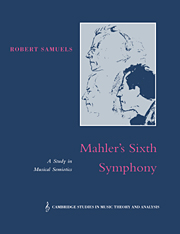Book contents
5 - Musical narrative and the suicide of the symphony
Published online by Cambridge University Press: 17 November 2009
Summary
One of the areas of contemporary literary theory which has provoked most comment from scholars outside its original field is ‘narrativity’. This interest may perhaps be dated to Roland Barthes' comment, that ‘the narratives of the world are numberless’ (Barthes 1977: 79), which directs attention to broader concerns than the mandarin inspection of literary texts. On the face of it, however, narrative is an unlikely topic for music theory, since music appears to lack the linguistic basis essential to the concept of narrative. Nevertheless, several recent attempts to adopt the terms of narrativity have demonstrated that the musical work is more susceptible to this sort of inquiry than one might at first think.
In terms of the semiotic theory presented here, the possibility of a code of musical narration represents the most abstract, or extroversive, mode of reference to be considered. It must be defined as a form of musical sign which has a signified without any immanent existence in the structures of the work. The analyses which follow are therefore in some ways more speculative than those in the preceding chapters; they attempt to identify respects in which narrative is the appropriate model for the discussion of Mahler's semiotic strategy, or in other words to bring theoretical consistency to that totem of Germanic Mahler scholarship, Musiksprache (Williamson 1991: 371-2).
At the head of this enterprise, once again, stands Adorno's now often-quoted aphorism, ‘It is not that music wants to narrate, but that the composer [Mahler] wants to make music in the way others make narratives’ (1960: 85/1992: 62).
- Type
- Chapter
- Information
- Mahler's Sixth SymphonyA Study in Musical Semiotics, pp. 133 - 165Publisher: Cambridge University PressPrint publication year: 1995



